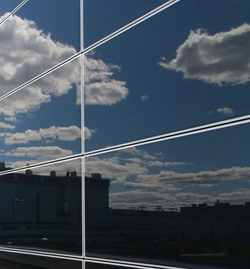
by Ann Withanee — June 6, 2011—Ruukki states that it is the first company to have developed a photovoltaic system that has been fully integrated into a façade to convert sun rays into energy. The solar power system does not depend on the sun’s warmth, only its radiation. The electricity generated is used either to meet the building’s own needs or is fed into the electricity grid.
The solar panel façade has been designed for application in buildings of a high architectural standard that comply with increasingly stricter environmental regulations. Developed and patented by Ruukki, the system is fully integrated into the façade and is the most cost-effective way on the market to make a fully glazed façade that generates energy from the sun. The system enables power to be produced even in areas with no direct sun rays since the technology can also utilize sun rays in cloudy weather. In snowy areas and next to water, the system increases output from reflected rays.
Ruukki’s solar power system is fully integrated into the façade of the building, both functionally and visually. In the façade of an average-sized office building in Finland, for example, Ruukki’s solar panel façade can produce 18,000 kWh of electricity a year. This is enough to meet the annual needs of a medium-sized, electrically heated small-family home. Output and capacity can easily be increased according to the area available and capacity requirement.
A solar panel façade is the easiest and most effortless way for a building to generate electricity, notes Ruukki. The system is based on modular solar power or PV panels, which have been made from glazed PV modules and Ruukki’s steel rainscreen panel system. The modules are almost black in color. They can be combined with Ruukki’s other façade products and are part of the Ruukki Design Palette range of façade products, allowing the size and shape of the other components in the façade to be freely defined. The PV modules are based on CIGS thin-film technology (Copper Indium Gallium Diselenide), which is a commonly used technology in solar cells.
The façade has been pre-designed, and delivery includes all the components and supplies required at the site, and with an also pre-designed cabling system, on-site installation is both fast and easy, says the company.
For more information visit the Ruukki Web site.




